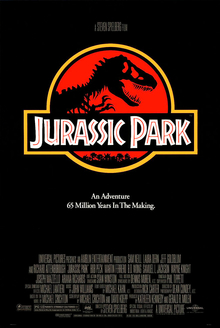
Back Jurassic Park (rolprent) Afrikaans Jurassic Park ALS Jurassic Park (cinta) AN الحديقة الجوراسية (فيلم) Arabic چوراسيك پارك (فيلم) ARZ Jurassic Park (película) AST Yura dövrü parkı (film) Azerbaijani ژوراسیک پارکی AZB Juras perėjuoda parks BAT-SMG Парк юрскага перыяду (фільм) Byelorussian
| Jurassic Park | |
|---|---|
 Theatrical release poster | |
| Directed by | Steven Spielberg |
| Screenplay by | |
| Based on | Jurassic Park by Michael Crichton |
| Produced by | |
| Starring | |
| Cinematography | Dean Cundey |
| Edited by | Michael Kahn |
| Music by | John Williams |
Production company | |
| Distributed by | Universal Pictures |
Release dates |
|
Running time | 127 minutes[1] |
| Country | United States |
| Language | English |
| Budget | $63 million[2] |
| Box office | $1.058 billion[3] |
Jurassic Park is a 1993 American science fiction action film[4] directed by Steven Spielberg, produced by Kathleen Kennedy and Gerald R. Molen, and starring Sam Neill, Laura Dern, Jeff Goldblum, and Richard Attenborough. It was written by Michael Crichton and David Koepp, based on Crichton's 1990 novel. The film is set on the fictional island of Isla Nublar, off Central America's Pacific Coast near Costa Rica, where wealthy businessman John Hammond (Attenborough), and a team of genetic scientists have created a wildlife park of de-extinct dinosaurs. When industrial sabotage leads to a catastrophic shutdown of the park's power facilities and security precautions, a small group of visitors, including Hammond's grandchildren, struggle to survive and escape the now perilous island.
Before Crichton's novel was published, four studios put in bids for its film rights. With the backing of Universal Pictures, Spielberg acquired the rights for $1.5 million before its publication in 1990. Crichton was hired for an additional $500,000 to adapt the novel for the screen. Koepp wrote the final draft, which left out much of the novel's exposition and violence, while making numerous changes to the characters. Filming took place in California and Hawaii from August to November 1992, and post-production lasted until May 1993, supervised by Spielberg in Poland as he filmed Schindler's List. The dinosaurs were created with groundbreaking computer-generated imagery by Industrial Light & Magic, and with life-sized animatronic dinosaurs built by Stan Winston's team. To showcase the film's sound design, which included a mixture of various animal noises for the dinosaur sounds, Spielberg invested in the creation of DTS, a company specializing in digital surround sound formats. The film was backed by an extensive $65 million marketing campaign, which included licensing deals with over 100 companies.
Jurassic Park premiered on June 9, 1993, at the Uptown Theater in Washington, D.C., and was released on June 11 in the United States. It was a blockbuster hit and went on to gross over $914 million worldwide in its original theatrical run,[5] surpassing Spielberg's own E.T. the Extra-Terrestrial to become the highest-grossing film of all time until the release of Titanic in 1997.[6] It also remains the highest-grossing film directed by Spielberg to date. The film was also a critical success, with praise directed at its special effects, sound design, action sequences, John Williams's score, and Spielberg's direction.[7] The film won over 20 awards, including three Academy Awards for technical achievements in visual effects and sound design. Following its 20th anniversary re-release in 2013, Jurassic Park became the oldest film in history to surpass $1 billion in ticket sales and the 17th overall.
In the years since its release, film critics and industry professionals have often cited Jurassic Park as one of the greatest movies of the action and thriller genres. The movie is also an example of a techno-thriller.[8] Jurassic Park's pioneering use of computer-generated imagery is considered to have paved the way for the special effects practices of modern cinema. In 2018, it was selected for preservation in the United States National Film Registry by the Library of Congress as "culturally, historically, or aesthetically significant". The film spawned a multimedia franchise that includes five sequels, two television series, video games, theme park attractions, comic books and various merchandise.
- ^ "Jurassic Park (1993)". American Film Institute. Archived from the original on June 10, 2022. Retrieved June 10, 2022.
- ^ "Jurassic Park". Box Office Mojo. Archived from the original on September 16, 2020. Retrieved May 9, 2021.
- ^ "Jurassic Park". The Numbers. Retrieved February 21, 2024.
- ^ "Jurassic Park (1993) - Steven Spielberg | Synopsis, Characteristics, Moods, Themes and Related". AllMovie. Archived from the original on August 4, 2020. Retrieved October 8, 2020.
- ^ "The Box Office Legacy Of 'Jurassic Park,' 20 Years Later". Forbes. April 5, 2013.
- ^ "It's a Titanic hit". The Tampa Tribune. February 25, 1998. p. 37. Archived from the original on August 22, 2022. Retrieved August 22, 2022 – via Newspapers.com.

- ^ Jurassic Park at Rotten Tomatoes
- ^ "Crypto, Sci-Fi, Soldiers, Spies (and Disasters, of Course): 5 Varieties in the Technothriller Genre". Writer's Digest. July 19, 2018. Archived from the original on July 28, 2019. Retrieved February 9, 2020.